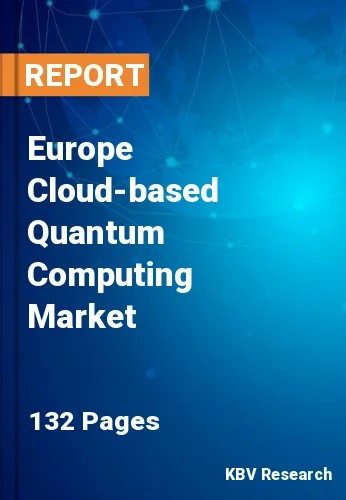Chapter 1. Market Scope & Methodology
1.1 Market Definition
1.2 Objectives
1.3 Market Scope
1.4 Segmentation
1.4.1 Europe Cloud-based Quantum Computing Market, by Solution
1.4.2 Europe Cloud-based Quantum Computing Market, by Technology
1.4.3 Europe Cloud-based Quantum Computing Market, by Application
1.4.4 Europe Cloud-based Quantum Computing Market, by Vertical
1.4.5 Europe Cloud-based Quantum Computing Market, by Country
1.5 Methodology for the research
Chapter 2. Market at a Glance
2.1 Key Highlights
Chapter 3. Market Overview
3.1 Introduction
3.1.1 Overview
3.1.1.1 Market Composition and Scenario
3.2 Key Factors Impacting the Market
3.2.1 Market Drivers
3.2.2 Market Restraints
3.2.3 Market Opportunities
3.2.4 Market Challenges
3.3 Porter’s Five Forces Analysis
Chapter 4. Strategies Deployed in Cloud-based Quantum Computing Market
Chapter 5. Europe Cloud-based Quantum Computing Market by Solution
5.1 Europe Software Market by Country
5.2 Europe Services Market by Country
Chapter 6. Europe Cloud-based Quantum Computing Market by Technology
6.1 Europe Superconducting Qubits Market by Country
6.2 Europe Trapped Ions Market by Country
6.3 Europe Quantum Annealing Market by Country
6.4 Europe Others Market by Country
Chapter 7. Europe Cloud-based Quantum Computing Market by Application
7.1 Europe Optimization Market by Country
7.2 Europe Simulation & Modelling Market by Country
7.3 Europe Sampling Market by Country
7.4 Europe Others Market by Country
Chapter 8. Europe Cloud-based Quantum Computing Market by Vertical
8.1 Europe BFSI Market by Country
8.2 Europe Healthcare Market by Country
8.3 Europe Automotive Market by Country
8.4 Europe Energy & Power Market by Country
8.5 Europe Aerospace & Defense Market by Country
8.6 Europe Government Market by Country
8.7 Europe Chemical Market by Country
8.8 Europe Others Market by Country
Chapter 9. Europe Cloud-based Quantum Computing Market by Country
9.1 Germany Cloud-based Quantum Computing Market
9.1.1 Germany Cloud-based Quantum Computing Market by Solution
9.1.2 Germany Cloud-based Quantum Computing Market by Technology
9.1.3 Germany Cloud-based Quantum Computing Market by Application
9.1.4 Germany Cloud-based Quantum Computing Market by Vertical
9.2 UK Cloud-based Quantum Computing Market
9.2.1 UK Cloud-based Quantum Computing Market by Solution
9.2.2 UK Cloud-based Quantum Computing Market by Technology
9.2.3 UK Cloud-based Quantum Computing Market by Application
9.2.4 UK Cloud-based Quantum Computing Market by Vertical
9.3 France Cloud-based Quantum Computing Market
9.3.1 France Cloud-based Quantum Computing Market by Solution
9.3.2 France Cloud-based Quantum Computing Market by Technology
9.3.3 France Cloud-based Quantum Computing Market by Application
9.3.4 France Cloud-based Quantum Computing Market by Vertical
9.4 Russia Cloud-based Quantum Computing Market
9.4.1 Russia Cloud-based Quantum Computing Market by Solution
9.4.2 Russia Cloud-based Quantum Computing Market by Technology
9.4.3 Russia Cloud-based Quantum Computing Market by Application
9.4.4 Russia Cloud-based Quantum Computing Market by Vertical
9.5 Spain Cloud-based Quantum Computing Market
9.5.1 Spain Cloud-based Quantum Computing Market by Solution
9.5.2 Spain Cloud-based Quantum Computing Market by Technology
9.5.3 Spain Cloud-based Quantum Computing Market by Application
9.5.4 Spain Cloud-based Quantum Computing Market by Vertical
9.6 Italy Cloud-based Quantum Computing Market
9.6.1 Italy Cloud-based Quantum Computing Market by Solution
9.6.2 Italy Cloud-based Quantum Computing Market by Technology
9.6.3 Italy Cloud-based Quantum Computing Market by Application
9.6.4 Italy Cloud-based Quantum Computing Market by Vertical
9.7 Rest of Europe Cloud-based Quantum Computing Market
9.7.1 Rest of Europe Cloud-based Quantum Computing Market by Solution
9.7.2 Rest of Europe Cloud-based Quantum Computing Market by Technology
9.7.3 Rest of Europe Cloud-based Quantum Computing Market by Application
9.7.4 Rest of Europe Cloud-based Quantum Computing Market by Vertical
Chapter 10. Company Profiles
10.1 Google LLC (Alphabet Inc.)
10.1.1 Company Overview
10.1.2 Financial Analysis
10.1.3 Segmental and Regional Analysis
10.1.4 Research & Development Expense
10.1.5 SWOT Analysis
10.2 Microsoft Corporation
10.2.1 Company Overview
10.2.2 Financial Analysis
10.2.3 Segmental and Regional Analysis
10.2.4 Research & Development Expenses
10.2.5 Recent strategies and developments:
10.2.5.1 Partnerships, Collaborations, and Agreements:
10.2.6 SWOT Analysis
10.3 IBM Corporation
10.3.1 Company Overview
10.3.2 Financial Analysis
10.3.3 Regional & Segmental Analysis
10.3.4 Research & Development Expenses
10.3.5 Recent strategies and developments:
10.3.5.1 Partnerships, Collaborations, and Agreements:
10.3.5.2 Geographical Expansions:
10.3.6 SWOT Analysis
10.4 Amazon Web Services, Inc. (Amazon.com, Inc.)
10.4.1 Company Overview
10.4.2 Financial Analysis
10.4.3 Segmental Analysis
10.4.4 Recent strategies and developments:
10.4.4.1 Geographical Expansions:
10.4.5 SWOT Analysis
10.5 Baidu, Inc.
10.5.1 Company Overview
10.5.2 Financial Analysis
10.5.3 Segmental Analysis
10.5.4 Research & Development Expenses
10.5.5 SWOT Analysis
10.6 Huawei Technologies Co., Ltd. (Huawei Investment & Holding Co., Ltd.)
10.6.1 Company Overview
10.6.2 Financial Analysis
10.6.3 Segmental and Regional Analysis
10.6.4 Research & Development Expense
10.6.5 SWOT Analysis
10.7 Terra Quantum AG
10.7.1 Company Overview
10.7.2 Recent strategies and developments:
10.7.2.1 Geographical Expansions:
10.7.3 SWOT Analysis
10.8 SpinQ Technology Co., Ltd.
10.8.1 Company Overview
10.9 QpiCloud Techonologies
10.9.1 Company Overview
10.10. CERN
10.10.1 Company Overview
10.10.2 SWOT Analysis

